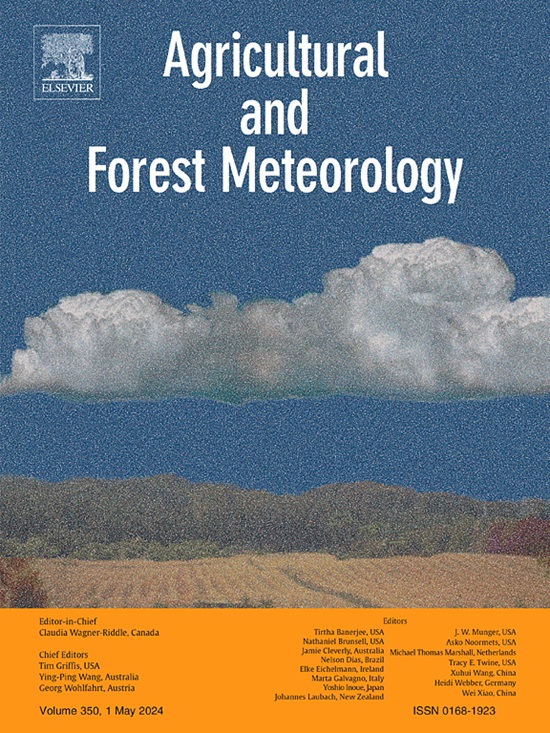对从放牧和施肥牧场得出的涡度协方差 N2O 排放量进行分区和驱动力分析
IF 5.6
1区 农林科学
Q1 AGRONOMY
引用次数: 0
摘要
通过各种氮(N)的输入,人工管理的牧场是温室气体一氧化二氮(N2O)的主要来源。迄今为止,人们一直使用室内测量来量化 N2O 排放量和特定排放源(如放牧牛的排泄物)的排放因子。本研究利用涡度协方差(EC)测量了瑞士东部放牧和施肥牧场三年的 N2O 排放数据集。利用随机森林对 N2O 通量进行了缺口填充和排放源分解(通量分区)。牧场中的排泄物氮沉积是根据牛群氮预算方法,利用观测到的牛群产奶量、体重和饲料摄入量估算得出的。此外,还进行了驱动因素分析,以量化一氧化二氮排放量与预测变量之间的关系。观测到的年 N2O 排放量分别为 5.3 ± 0.8、3.1 ± 0.5 和 4.4 ± 0.7 千克 N2O-N ha-1 yr-1,并细分为背景、肥料和排泄物相关的 N2O 排放量,所占比例分别为 27-46%、15-40% 和 30-51%。将排泄物一氧化二氮通量与排泄物氮输入量相结合,得出牛排泄物的平均排放因子 (EF) 为 1.1 ± 0.5 %,往往高于气候潮湿地区的 IPCC 默认值 0.6 %。虽然一氧化二氮的最大排放量通常出现在施肥后和最佳土壤湿度条件下,但在夏季较长的干旱期间也会出现明显的一氧化二氮排放峰值,并可作为降水和先前放牧活动的函数进行参数化。此外,N2O 排放峰值出现在寒冷季节的低温条件下,这也应在今后的研究中加以考虑。总之,我们认为,在牧场条件下进行EC测量,然后用随机森林进行通量分配,适用于量化不同来源的牧场N2O排放量。本文章由计算机程序翻译,如有差异,请以英文原文为准。
Partitioning and driver analysis of eddy covariance derived N2O emissions from a grazed and fertilized pasture
Managed pastures are strong sources for the greenhouse gas nitrous oxide (N2O) through various nitrogen (N) inputs. So far, chamber measurements have been used to quantify N2O emissions and emissions factors of specific emissions sources like grazing cattle excreta. This study presents a three-year dataset of N2O emissions from a grazed and fertilized pasture measured by eddy covariance (EC) in eastern Switzerland. N2O fluxes were gap-filled and disaggregated into the emission sources (flux partitioning) by using random forest. The excreta N deposition in the pasture was estimated based on a cattle nitrogen budget approach using observed milk yield, body weight and feed intake of the cattle herd. Furthermore, a driver analysis was performed to quantify the relationship between N2O emissions and predictor variables. The observed annual N2O emissions amounted to 5.3 ± 0.8, 3.1 ± 0.5 and 4.4 ± 0.7 kg N2O-N ha-1 yr-1 and were disaggregated into background, fertilizer and excreta related N2O emissions with contributions of 27–46 %, 15–40 % and 30–51 %, respectively. Combining the excreta N2O fluxes with the excreta N inputs resulted in an average emission factor (EF) for cattle excreta of 1.1 ± 0.5 %, that tends to be higher than the IPCC default value of 0.6 % for wet climates. While maximum N2O emissions usually were observed after fertilizer application and under optimum soil moisture conditions as expected, distinct N2O emission peaks also occurred during a longer drought period in summer and could be parametrised as a function of precipitation and previous grazing activity. Moreover, peak N2O emissions occurred during the cold season at low temperatures and should be considered in future studies. Overall, we suggest that EC measurements under pasture conditions with subsequent flux partitioning by random forest are suitable for quantifying pasture N2O emissions of different sources.
求助全文
通过发布文献求助,成功后即可免费获取论文全文。
去求助
来源期刊
CiteScore
10.30
自引率
9.70%
发文量
415
审稿时长
69 days
期刊介绍:
Agricultural and Forest Meteorology is an international journal for the publication of original articles and reviews on the inter-relationship between meteorology, agriculture, forestry, and natural ecosystems. Emphasis is on basic and applied scientific research relevant to practical problems in the field of plant and soil sciences, ecology and biogeochemistry as affected by weather as well as climate variability and change. Theoretical models should be tested against experimental data. Articles must appeal to an international audience. Special issues devoted to single topics are also published.
Typical topics include canopy micrometeorology (e.g. canopy radiation transfer, turbulence near the ground, evapotranspiration, energy balance, fluxes of trace gases), micrometeorological instrumentation (e.g., sensors for trace gases, flux measurement instruments, radiation measurement techniques), aerobiology (e.g. the dispersion of pollen, spores, insects and pesticides), biometeorology (e.g. the effect of weather and climate on plant distribution, crop yield, water-use efficiency, and plant phenology), forest-fire/weather interactions, and feedbacks from vegetation to weather and the climate system.

 求助内容:
求助内容: 应助结果提醒方式:
应助结果提醒方式:


